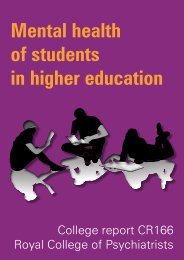Universities
Universities that Count - EAUC
Universities that Count - EAUC
- No tags were found...
Create successful ePaper yourself
Turn your PDF publications into a flip-book with our unique Google optimized e-Paper software.
2. Introductionfor comparing environmental management andperformance with peers.The CR Index is the UK’s leading benchmarkof responsible business, helping organisationsto integrate and improve responsible businesspractice across their business. The Index providesa systematic approach to managing, measuringand reporting an organisations impact on societyand the environment.2.1.1 Benefits of benchmarkingWhen used as a management tool, both theEnvironment and CR Index can provide a numberof benefits:• Provides a useful framework to supportorganisations in identifying material andemerging issues.• Brings different functions in an organisationtogether to support understanding andmanagement of their CR/environmental keyissues.• Reinforces good practice already undertakenwithin an organisation and drives furtherimprovement through gap analysis.• Enables organisations to benchmarkthemselves against their peers and otherIndex participants.• Provides a practical framework for improvingand communicating performance to bothinternal and external stakeholders.• Challenges whether the organisation isconducting CR/environmental activities in asystematic and integrated way.• Can help build stakeholder trust, by providingcredible, independent information tostakeholders, demonstrating an organisationscommitment to transparency.2.2 Benchmarking the HE sectorTraditionally HEIs are not considered asbusinesses, yet in most cases share similarcharacteristics and are under similar pressures tocompanies in terms of social and environmentalimpacts, risks, opportunities and accountability tostakeholders. For example HEIs:• Provide a significant contribution to theeconomy of the region in which they arebased.• Turn over considerable sums of money.• Are large employers - often competing fiercelyfor top quality staff.• Have significant supply chains.• Work hard to attract customers (students).• Have an environmental impact that mustbe increasingly well managed withintighter legislative boundaries and higherexpectations.• Have student populations, researchprogrammes, resources and facilities thatimpact on both local and in some casesglobal communities.Further, HEIs are ‘future-shapers’:• Directing research, markets, science,technology and values.• Providing the next generation of society’sprofessionals, politicians and leaders.2.2.1 Benchmarking the HE sector in fiveyears timeThe HE sector will come under increasingscrutiny from stakeholders in terms of the waythey operate. They will feel a similar pressure todemonstrate responsible behaviour and promotetheir sustainability. The introduction of variabletuition fees will bring a ‘market’ effect that is newto the sector, and transparency will be a necessarypart of enhanced brand management and ‘licenceto operate’ – akin to the private sector.The institutions which are reducing their carbonfootprint, introducing eco-efficiencies, greeningtheir supply chains, collaborating with theircommunities and providing supportive as wellas excellent places to work and study will be theinstitutions selected by staff and students wantingto align their futures with the organisations thatshare their values. A HEI’s corporate responsibilityor sustainability reputation will be among the topconsiderations for staff and students when makingtheir choice.<strong>Universities</strong> that Count





